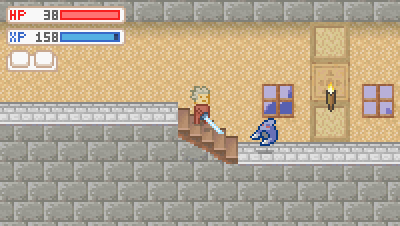Retro Replay Review
Gameplay
Ainevoltas II builds on the tight, responsive controls of its predecessor, offering players a satisfying blend of classic 2D platforming and light RPG progression. Justin’s moveset—jumping, attacking, and ducking to trigger health regeneration—feels intuitive from the first stage. The addition of an experience bar that fills as you defeat monsters adds subtle depth, rewarding careful combat and exploration in equal measure.
(HEY YOU!! We hope you enjoy! We try not to run ads. So basically, this is a very expensive hobby running this site. Please consider joining us for updates, forums, and more. Network w/ us to make some cash or friends while retro gaming, and you can win some free retro games for posting. Okay, carry on 👍)
Exploration lies at the heart of the experience. Each level is sprinkled with hidden alcoves, breakable walls, and secret chambers hiding gems that unlock powerful new abilities. Whether you’re boosting your jump height, increasing your strength, or unleashing a swarm of insects that automatically attack nearby foes, these upgrades keep the core platforming loop fresh and encourage players to scour every corner.
RPG elements also extend to skill trees, where earned points can be allocated to health, strength, jump power, and the new health recovery skill. This system gives players agency over Justin’s development, letting newcomers focus on survival while veterans can lean heavily into offense. Optional guild missions offer additional challenges and rewards, adding a welcome side quest structure that breaks up the main campaign.
Once you’ve conquered the main story, the New Game+ mode invites you to replay as Amos or even the iconic Richter Belmont from Castlevania. Each character brings a distinctive combat style—Amos relies on brute force, while Richter wields a whip, calling upon flying bibles and a flaming cross special attack that trades a sliver of your experience for explosive damage. This mode dramatically extends replayability and showcases the thought put into post-game content.
Graphics
Visually, Ainevoltas II pays homage to 16-bit-era platformers but adds modern flourishes that prevent it from feeling dated. Character sprites are crisp and well-animated, with smooth transitions between idle, attack, and jump frames. The monsters you encounter range from grotesque aberrations to mischievous imps, each drawn with care and distinct color palettes that help them pop against the backgrounds.
Levels span haunted forests, crumbling ruins, and subterranean caverns, each rendered with layered parallax scrolling that gives a convincing sense of depth. Subtle particle effects—falling leaves, drifting embers, magical glows—add atmosphere, while dynamic lighting highlights traps, secret passages, and environmental hazards, guiding the player without resorting to intrusive on-screen markers.
While some reused assets from the original Ainevoltas are present, the sequel dresses them up with updated animations and richer textures. Backgrounds are detailed enough to reward repeat visits, revealing new visual jokes or narrative clues tucked into murals, signposts, and NPC portraits. Even UI elements, like the XP bar and skill menus, feel polished and animated, reinforcing the game’s old-school charm with a contemporary sheen.
Story
Set eleven years after the climactic defeat of Azazel, Ainevoltas II picks up with Justin returning to his home of Aengsvik, now overrun by a fresh wave of monsters. The setup is familiar, but the narrative evolves through deadpan humor and offbeat dialogue. NPCs deliver quips that range from dry puns to outright absurdity, which keeps the tone light even as you delve into darker underground dungeons.
Side quests—such as helping the local blacksmith retrieve cursed ore or assisting a guild in investigating a mysterious tower—serve as both world-building and optional distractions. If you choose, you can even court and marry an in-game character, leading to a brief but sweet sequence where Justin welcomes a child into his adventuring life. These moments, though superficial, add warmth and a sense of personal stakes to the overarching monster-slaying plot.
The sequel also plays with genre conventions in its New Game+ chapter. Bringing in Richter Belmont from Castlevania isn’t just a flashy cameo; it weaves an alternate perspective into the core storyline, complete with unique dialogue and self-referential humor. Whether you view it as fan service or a clever twist, it underscores the developers’ willingness to experiment with narrative structure while staying true to the game’s tongue-in-cheek spirit.
Overall Experience
Ainevoltas II strikes a superb balance between the immediacy of platforming and the progression loops typical of RPGs. The core mechanics are solid, the level design encourages thorough exploration, and the skill system provides meaningful choices without overwhelming newcomers. Teleportation to discovered areas further smooths out pacing, eliminating backtracking frustration and letting you focus on discovery.
With its blend of challenging boss encounters, myriad secrets, and side activities, the game delivers excellent value for both casual players and completionists. The automatic save feature ensures you can jump in and out of sessions without penalty, which is ideal for shorter play bursts or marathon runs alike. Post-game content—especially the ability to replay as Amos or Richter—adds a layer of longevity few platformers achieve.
The presentation, marrying retro aesthetics with contemporary polish, never feels like a mere nostalgia trip. Sound design complements the visuals with catchy chiptune melodies and visceral attack effects, heightening both the whimsy and the tension. Overall, Ainevoltas II is a well-crafted sequel that honors its roots while expanding its horizons, making it a must-play for any fan of 2D platformers with a twist.
 Retro Replay Retro Replay gaming reviews, news, emulation, geek stuff and more!
Retro Replay Retro Replay gaming reviews, news, emulation, geek stuff and more!









Reviews
There are no reviews yet.